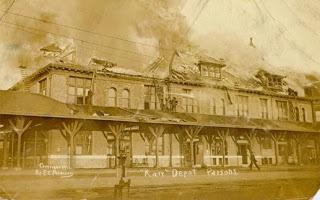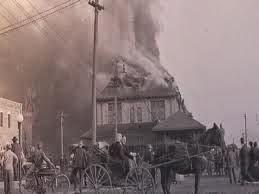The Missouri-Kansas and Texas Railroad (the Katy), because of its route through Indian Territory, was one of the most targeted rail lines in the country. It passed through large stretches of sparsely inhabited land which made it easy to rob. Gangs were targeting the Katy shortly after it laid the first tracks into the Cherokee Nation.
In response to this constant threat, the railroad hired lawmen to ride the rail line, particularly if a large shipment of money or goods was being transported. In 1894, Bud Ledbetter was hired by an express company to police the railroad. He was on the Katy in mid-November of that year when one of the more famous train robberies occurred.
The year 1894 had seen a great deal of outlaw activity. It was during this time that the U.S. government made a large payment to Cherokee citizens for the purchase of the Cherokee Strip — a northern section of land along the Kansas border. With so much money being transported and changing hands, bandits saw an opportunity for easy spoils.
John Moore, a railroad agent under Bud Ledbetter, told the story of two robberies that took place near the Katy Station, Parsons, Kansas in 1894. His account seems to suggest that he was seeking a reward and fame as an investigator, or that he was no better than the robbers who did the job. A couple of bandits robbed the Katy of $35,000 in gold coin and buried it along the tracks in a leather sack. A month later, the same bandits robbed another Katy train at the same place, this time acquiring $50,000 in gold coin. They put the coins in a small leather trunk and buried it beside the tracks. The outlaws were tracked to Wichita and killed resisting arrest, never revealing where the loot was buried. John Moore searched many years for the caches without ever recovering the gold, before ever revealing that he knew that the money was buried along the tracks.
What are the odds that two train robbers would be lucky enough to rob two different trains, one month apart, with this much money? Most gangs never saw that amount of money if you added all the banks and trains they robbed together. Mr. Moore surely tipped his two partners of the trains to rob, not counting on their untimely demise. The revelation of the caches coincidently, if you believe in coincidences, surfaced at the same time the Katy Station in Parsons, (accidently) burned, destroying all records, making research into any investigation into the robbery and John Moore's involvement tough.
One thing is sure, John Moore did not spend all those years hunting nothing up and down those railroad tracks, keeping it secret what his search was about. What's $85,000 in gold coins from the 1890's worth today? ANSWER: It's worth a look or two up and down those old tracks!
May all of your trails be smooth and your treasure sites many.
Best Wishes and Good Hunting


Katy Depot fire, March 18, 1912, Parsons, Kansas
